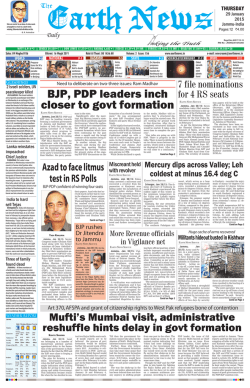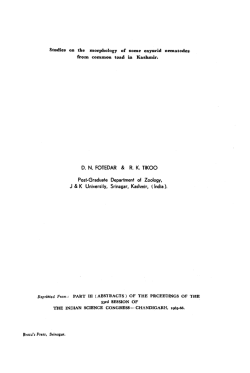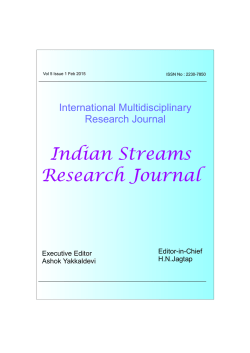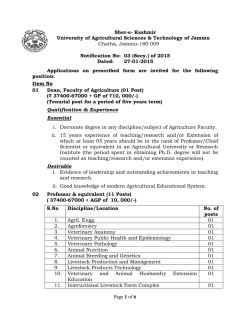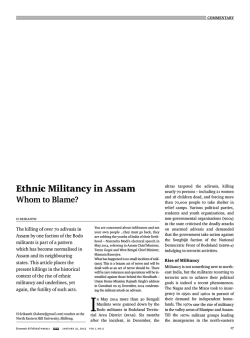
Download PDF version - Economic and Political Weekly
NOTES Conflict of Kashmir and the Problem of Disappearance Paul D’Souza The disappearance of young men without any trace in Kashmir over the last three decades of conflict is a reason for anguish and agitation in the region. For families and close relatives of the disappeared, the issue goes beyond the politics of freedom. In the context of the worldwide phenomenon of “enforced disappearances” this article looks at the problem of disappearances in a conflict region of India and the challenges faced by the families as well as those for a democratic society. Paul D’Souza ([email protected]) is with the Indian Social Institute, New Delhi. 78 O ver the past three decades or so Kashmir has experienced political, social, economic and cultural turmoil and has suffered enormous hardship. Thousands of people, mostly young men, have disappeared. Whatsoever the reasons for their disappearances, the immediate victims of such disappearances are the families and wives of the disappeared persons. The wives they left behind are known as “half-widows”.1 Jammu and Kashmir saw yet another election, these “waiting people of Kashmir” expect that democracy will bring an end to their wait by going beyond the politics of freedom. Definition and Context The International Convention for the Protection of All Persons from Enforced Disappearance (ICCPED 2006) defines enforced disappearance as “the arrest, detention, abduction or other form of deprivation of liberty committed by agents of the State or by persons or groups of persons acting with the authorisation, support or acquiescence of the State, followed by a refusal to acknowledge the deprivation of liberty or by concealment of the fate or whereabouts of the disappeared person, which place such a person outside the protection of the law” (Article 2). However, there is a significant departure in the Rome Statute of the International Criminal Court (1998) which widens the definition, and includes non-state actors – persons acting with the “authorisation, support or acquiescence” of non-state political organisations. There are a variety of reasons why people disappear or their whereabouts remain unknown. They may be refugees, displaced persons forcibly detained or recruited to fight and are without any means of communication, or people who have died and whose identities were not recorded (ICRC 2006). In prehistoric times people used to settle scores with each other by capturing each other’s kin. But in modern times it has attained alarming connotations as enforced disappearances take place with the active connivance and support of the establishment and power groups (Zahir 2012). “Enforced disappearances were used by the Nazi regime during second world war to deliberately spread terror throughout the population and to suppress dissent” (Anderson 2006). Enforced disappearance became more widely practised during the 1960s and 1970s by many Latin American military regimes in Guatemala, El Salvador, Brazil and Argentina. It was the military regimes in Latin America that popularised the practice. Today enforced disappearance is taking new forms and has become a global phenomenon. The instances of disappearances studied show that people are made to disappear not only by statesponsored agencies but also by other parties like militant organisations, militia, terrorists, drug mafia, etc, for different reasons and motives. Political neglect, war, and poverty are said to push desperate groups into such abductions and kidnappings as a means of livelihood, e g, pirates from Somalia. Even without factors like war or poverty, wherever law-enforcement agencies abandon their duty of protecting citizens, unscrupulous elements take to this as an easy way of making money. At the political level, “disappearances” are used by ruthless men in power for silencing their opponents and critics by creating fear. This has been resorted to by several dictators in South America, Africa and Asia. In recent times human rights groups and activists have pointed to several such disappearances of journalists who were critical of the government in Sri Lanka. “Enforced disappearances have become ‘a truly universal phenomenon’, believed to be occurring in approximately 90 countries, in all regions of the world and affecting tens of thousands of people” (Anderson 2006). As on 2012, the United Nations Working Group on Enforced or Involuntary Disappearances estimated that at least 42,889 people worldwide JANUARY 31, 2015 vol l no 5 EPW Economic & Political Weekly NOTES have been victims of forcible disappearance with fates unknown (Amnesty International). In South Asia, Sri Lanka has the highest number of recorded disappearances followed by Kashmir in India. Addressing the Issue The International Day of the Victims of Enforced Disappearances is observed annually on 30 August. The initiative came in 1983 due to the alarming rise of disappearances by authoritarian regimes in Latin America. The Latin American Federation of Associations for Relatives of the Detained-Disappeared (FEDEFAM), an association of delegates from member states and regional groups working against secret imprisonment and forced disappearances, led the campaign. On 21 December 2010, the UN General Assembly decided to declare the special day to draw world attention to the fate of individuals who have disappeared – either imprisoned and held in poor conditions, or killed and never identified. So their relatives and legal representatives never come to know what happened. On 21 December 2010, by its resolution 65/209, the UN General Assembly welcomed the adoption of the “International Convention for the Protection of All Persons from Enforced Disappearance”. Many countries have established commissions to deal with the problem of enforced disappearances. Their task is to probe enforced disappearances and identify the guilty and punish them. In recent years, activists, non-governmental organisations (NGOs), courts, and international organisations have increasingly sought to highlight and prevent enforced disappearances and obtain retroactive justice for victims. The enforced disappearance, which was a barbaric global phenomenon, has ceased now in many parts of the world, particularly in Latin American countries and south-east Asian countries like Indonesia, Thailand and the Philippines (Noorani 2003). The Association of Parents of Disappeared Persons (APDP), a group of families of victims of enforced or involuntary disappearances in Jammu and Kashmir, says that 8,000 to 10,000 people have been missing during different regimes since 1989 (APDP 2011). This article is based on Economic & Political Weekly EPW JANUARY 31, 2015 intensive research carried Figure 1: Disappearances and Phases of Militancy Distribution of those disappeared (%) out over a year that in50.0 50.0 cludes interviews with 150 30.0 30.0 half-widows,2 geographically spread across nearly 140 8.7 8.7 5.3 5.3 4.0 4.0 2.0 2.0 villages and towns in eight Outbreak Containment Turnaround Restoration of Restoration of districts of the Kashmir Gathering Storm (1990-92) (1993-94) (1995-96) Normalcy - I Normalcy - II (1988-89) (1997-2005) (2006-13) Valley and the Poonch disefforts made for restoration of normalcy trict of Jammu region. Similarly, extensive case studies, interviews and focus had their bearing on the course and group discussions were conducted with intensity of militancy. The Lahore bus half-widows, their family members and yatra and Kargil war 1999, the unilateral stakeholders from different walks of life, ceasefire till May 2001, and the attack i e, the human rights commission, advo- on the Jammu and Kashmir Legislative cates, health personnel, academicians, Assembly in October 2001 are examples government officials, civil society groups, of political initiatives and derailments of processes. journalists, and community members. It is significant to relate the number of When the Men Disappeared cases of disappearances of the sample Bloeria (2012), while providing an over- respondents to different phases of miliview of militancy in Jammu and Kashmir, tancy in Jammu and Kashmir and the describes five distinct phases of militancy militarisation that followed. Militancy since it began in September 1988. The in Kashmir was at its peak in the late first phase is the “gathering storm” that 1990s, the outbreak phase. The Armed spans the initial two years (1988-1989), Forces (Special Powers) Act (AFSPA) was when militancy was firmly planted on introduced in the state in 1990 to fight the soil of the state. The second phase, militancy. It saw an exodus of young “the outbreak”, lasted for three years people across the Line of Control (LoC), (1990-92) spreading its activities beyond resulting in brutal state action. This reSrinagar, where large-scale kidnapping flects in the data that 30% of disappearand killing took place as well as ethnic ances have taken place in the period cleansing leading to large-scale migration 1990-92 (Figure 1). Post declaration of of Kashmiri Pandits. The “containment ceasefire by the Jammu Kashmir Liberaphase”, which lasted for the next two tion Front (JKLF) in 1996, there was a dip years (1993-1994), saw the establishing in militant action. However, in the latter of Unified Headquarters (UHQ) to coor- part of 1997, Hizbul Mujahidin made a dinate the control systems and the full-fledged attempt to revive militancy launching of the All Parties Hurriyat with little success, which might help Conference (APHC) of 23 separatist outfits. explain why the highest number of The fourth phase in the militancy was disappearances (50%) happened in the that of “turnaround” (1995-1996), when period 1997-2005. This is the first phase the security forces gained the upper hand of re-establishment of the political process over the militants and Village Defence and restoration of normalcy. Of the total 150 in the sample survey, 80% of the disCommittees (VDCs) were constituted. However, during this period a large appearances took place during these number of foreign terrorists were in- two phases of militancy in the state. ducted, who in fact effectively took over the control of the operation from local Who Disappeared? cadres. The fifth and continuing phase of militancy is “re-establishment of political process and restoration of normalcy”. The electoral process which began in 1996 was further consolidated with subsequent elections in 1998, 1999, 2004, and local body election in 2005 after a gap of over 27 years. A number of vol l no 5 The disappeared men are certainly ruralbased; more than 90% were spread across nearly 140 villages of eight districts of the Kashmir Valley and the Poonch district of Jammu region. The concentration of the disappearances is in the region of Kashmir with a Muslim majority. The identified sample shows Muslims (99%) 79 NOTES Figure 2: Age and Education of the Disappeared (in %) 75 62.7 62 60 45 30 20.7 16 12.7 15 0 4.7 25 << 25 41-50 >51 25-40 41-50 >51 Age at disappearance Age at disappearance and only one was Hindu (Kashmiri Pandit). Among the Muslims 4% were Shia and the rest Sunni. Of the total sample surveyed, most of the men who disappeared were not well educated. Nearly 63% of them were illiterate and 30% had just completed primary or secondary school education. Just around 7% were educated beyond inter level (Figure 2). On the other hand, the disappeared men were mostly young; nearly 83% of them were between 25 and 50 years old. Nearly 13% of men were below the age of 25 when they disappeared. This is why the issue of disappearance becomes more volatile and a reason for anguish and agitation in the region. The age, education and geographical locations seem to be important parameters when men are picked up either by militants or by state forces. If the conflict of Kashmir is primarily related to the struggle for freedom then the young and illiterate men from rural Kashmir have fallen prey to the stuggle for azadi and its consequences. The “azadi” seems to be of prime importance to the Muslims and among Muslims, the Sunnis, the majority in the region. The disappearances are closely associated to one’s sociopolitical association. The possible agencies or perpetrators responsible for men’s disappearances in Jammu and Kashmir, according to the family members, are either the militant groups or the state forces; some are sure and others are not. There are claims and counterclaims on the same. One is aware that naming the agency/group/forces responsible for disappearance is not that easy and the question of one’s affiliation to either group would invite trouble. When asked if her husband was affiliated to any group, majority of the half widows (85%) 80 14.7 4.7 2 Illiterate Primary Intermediate Graduation Primary Level (upSecondary to 8thSecondary class) (9-10 class) Intermediate Graduation Level (up to (9-10 class) Education level 8th class) Education level confirmed that their husbands were not affiliated to any groups or they did not know about it. However, 9% of women confirmed that they were aware of their husbands being affiliated to some militant groups. Apart from army and militant disappearances, there are also abductions and disappearances instigated by the ikhwanis or renegades. Also, all disappearances have not been caused due to allegiance with the military or militants. Many disappearances have been caused in order to settle personal grudges or for personal reasons like land disputes, marital disputes, etc. Challenges to Democratic Society When people disappear, there are two kinds of victims: the individuals who have gone missing and their families, torn between despair and hope, living with uncertainty and pain, waiting for news, sometimes for decades (ICRC 2014). In a sense it is not merely the abducted person who is held hostage. The family and relatives too are held hostage till they are able to see the person back with them. The family of the “missing person” faces socioeconomic hardships, physical suffering, and psychological trauma. In that context the phenomenon of enforced disappearance has become a severe scourge in terms of the fear it generates, anxiety it breeds, fatigue it inflicts, and the psychological strain it imposes on the relatives of the disappeared (Zahir 2012). The available literature shows that due emphasis is given to the problem of disappearances but not sufficiently to the issues of halfwidows who are intimately related to the problem of disappearances in the conflict region of Jammu and Kashmir. Women in this situation of conflict and violence struggle silently and often the magnitude of the damage suffered by them goes unnoticed. This happens often with the death, disappearance, or disability of the male member in the armed conflict region (Qutab 2012). In Jammu and Kashmir, women have not been the direct targets of violence, yet their suffering is severe and long-drawn. By conservative estimates, there are 1,500 half widows in Kashmir.3 The various kinds of socio-economic hardship have effects on half-widows which in turn deeply affect their children, family and society at large. Thus, the plight of half widows of Kashmir is not only a “women’s issue” but something that affects families, communities and society as a whole. The challenges faced by the families of these victims, their communities and society are many on varied fronts. (1) Among the many difficulties of dealing with the phenomenon of enforced disappearance the first is the anonymity of the group involved, mainly when disappeared men are civilians and not affiliated to any group. As the men were picked up when they were out of the house or at workplaces, etc, the family members and relatives are not sure who the perpetrators are. When the identity of the kidnappers is not known, families do not know what to do to get their men released. (2) The second important difficulty is accessing information on disappeared persons. The information on disappeared persons is extremely difficult to come by. Because of the way these groups operate it is nearly impossible to obtain precise and reliable information on the whereabouts of disappeared persons and their fate. When the location of the disappeared person is not known, it is impossible to initiate concrete searches or legal action. In Kashmir their families and relatives have gone from pillar to post, searching for their missing men. They have gone to police stations, jails, hospitals, army camps and far-off villages. Getting reliable information about their whereabouts is an uphill task for most. In the absence of any information, families just wait and hope, as effort after effort proves futile. (3) Another frustrating difficulty families face is the inability even to protest. Even when they do know or have strong JANUARY 31, 2015 vol l no 5 EPW Economic & Political Weekly NOTES suspicions about the perpetrators responsible for the disappearance, their political or money power makes families feel helpless. Any action to secure information or in some cases even to protest against the crime becomes dangerous. The family and relatives feel they are caught between the devil and the deep blue sea. This is what happened to a Kashmiri woman, whose husband suddenly disappeared. Her relatives and villagers restrained her from lodging even a first information report (FIR) against the suspected perpetrator, fearing more disappearances if she did so. A community leader said, “We are aware that naming the group or organisation responsible for disappearance will have immense consequences.” (4) Enforced disappearances are complex issues and complexities are multiplied when these happen in conflict zones or when international terrorists or militants are involved. Going beyond the families and communities, in dealing with enforced disappearances there are many stakeholders including the state and they all get involved in the process. But this presents another difficulty: handling different opinions arising out of differences between various stakeholders in the perception of issues and possible actions. A well-coordinated effort, with clear, open communication channels between all the stakeholders is what is needed. But what often happens is everyone has a different stand on the causes and remedies. There have been instances when politicisation of the issue has been counterproductive and a hindrance to the process of delicate negotiations with the agencies involved. (5) Another challenge that all those interested in the welfare of the disappeared person have to face is the difficult nature of the process of negotiation, if any, with the agency involved in abduction or kidnapping. This is an extremely difficult and delicate challenge. Since negotiation usually means “a give and take”, there will be different opinions on what to “give”. Yielding to the demands may mean a compromise on principles and ethics. While those who are at a distance may take an ethical stand of not negotiating Economic & Political Weekly EPW JANUARY 31, 2015 with groups that indulge in human rights violations, those close to the disappeared person may insist on giving in to the demands of the abductors in order to secure the release of the person to whom they are emotionally attached. They may take the stand that since human life is more precious than anything else; any price can be paid in order to save it. There was vigorous debate in the US media over the recent release of the American soldier Bowe Bergdahl after having been held by the Taliban in Afghanistan for five years. The Taliban agreed to free him in exchange for five Taliban leaders jailed by the US. The exchange raised many troubling questions and the American public opinion remains divided. “Opponents fear that the exchange will encourage hostage takers worldwide, while supporters said that no American should be left behind no matter the cost” (Zlatica 2014). The challenges posed by “disappearances” are indeed threats to any democratic society. The Kashmir dispute is a complex, sensitive and polarising issue. The enforced disappearances of large numbers of persons in Kashmir have not evoked much concern in the country as it should have (Noorani 2003). As Gupta (2014) says, no army likes to fight its own people and that too for decades. In a mature and confident democracy, it is time that we are more willing to look within and create space for reconciliation. While people of Kashmir expect an urgent political solution to the existing conflict, for family members, the disappearance of close relatives is an issue that goes beyond the politics of freedom. Thus, anguish and agitation of those “waiting in hope for the disappeared” should evoke national concern and urgent attention. Notes 1 The term “half widows” refers to women who do not know whether their husbands are alive or dead. Urvashi Butalia mentions that “in Kashmir there are large numbers of women who are identified as ‘half widows’ – women whose husbands are assumed dead but there is no proof to show they actually are” (2002: xii). Ritu Dewan used the term to refer to the women whose husbands were “missing” and the legal position of their status was yet to be clarified both by the clergy and the law (2002: 151). There are references that “halfwidow” is a term coined by the Kashmiri press vol l no 5 2 3 to describe women whose husbands are missing (Rashid 2011). The selected samples for the study were only of the “half widows”, hence the cases of disappearances of men who were not married are not included in this study. The informal discussions revealed that higher number of disappearances were of young unmarried men. The analysis is not a reflection of the actual number of disappearances in Jammu and Kashmir. The estimate is born by extrapolation from a three-year door to door survey in district Baramulla (APDP 2011). The other independent commentators estimate the number of widows and half widows in Kashmir to be between 15,000 and 20,000 (Kazi 2009: 148). There has been no survey providing the exact number of widows and half widows in the region. The figures provided by the government and the civil society organisations vary widely (Qutab 2012). References Anderson, Kirsten (2006): “How Effective Is the Enforced Disappearance Convention?”, Melbourne Journal of International Law, Vol 7, viewed on 30 October 2014, http://www.law. unimelb.edu.au/files/dmfile/download65131. pdf APDP (2011): “Half Widow, Half Wife, Responding to Gendered Violence in Kashmir”, APDP, July. Bloeria, S S (2012): “Conflict Overview” in V R Raghavan, Conflict in Jammu and Kashmir: Impact on Polity, Society and Economy (New Delhi: Vij Books). Butalia, Urvashi, ed. (2002): “Speaking Peace: An Introduction” in Urvashi Butalia (ed.), Speaking Peace: Women’s Voices from Kashmir (New Delhi: Kali for Women), pp ix-xxiv. Dewan, Ritu (2002): “What Does Azadi Mean to You?” in Urvashi Butalia (ed.), Speaking Peace: Women’s Voices from Kashmir (New Delhi: Kali for Women), pp 149-61. Gupta, Shekhar (2014): “Haider in the Time of Hashtag Nationalism”, India Today, 20 October, pp 20-21. ICCPED (2006): “The International Convention for the Protection of All Persons from Enforced Disappearance”, viewed on 30 October 2014, http://www.hrea.org/index.php?doc_ id=223&erc_doc_id=3761&category_ id=881&category_type=2&group ICRC (2006): “The Missing Persons, ICRC Progress Report”, August, International Committee of the Red Cross, viewed on 30 October 2014 (https://www.icrc.org/eng/assets/files/other/ icrc_002_0897.pdf – (2014): “Missing Persons Must Not Be Forgotten”, viewed on 30 October 2014, https://www. icrc.org/eng/resources/documents/newsrelease/2014/08-28-day-disappeared-missing. htm Kazi, Seema (2009): Between Democracy and Nation – Gender and Militarization in Kashmir (New Delhi: Women Unlimited). Noorani, A G (2003): “‘Disappearances’ in Kashmir”, Economic & Political Weekly, Vol 38, No 26, pp 2592-93. Qutab, Soludia (2012): “Women Victims of Armed Forces”, Sociological Bulletin, Vol 61, No 2, pp 255-78. Rashid, Afsana (2011): Widows and Half-widows (New Delhi: Nice Printing Press). Zahir, Ud Din (2012): Did They Vanish in Thin Air?, Vol 2 (Srinagar: Awaisi Publications). Zlatica, Hoke (2014): “Americans Divided over Soldier’s Release in Exchange for Taliban”, Voice of America, June, viewed on 30 October 2014. 81
© Copyright 2026





